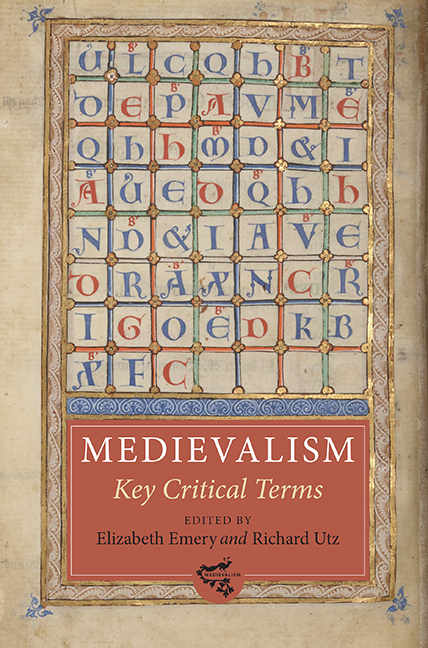Book contents
- Frontmatter
- Dedication
- Contents
- List of Illustrations
- List of Contributors
- Making Medievalism: A Critical Overview
- 1 Archive
- 2 Authenticity
- 3 Authority
- 4 Christianity
- 5 Co-disciplinarity
- 6 Continuity
- 7 Feast
- 8 Genealogy
- 9 Gesture
- 10 Gothic
- 11 Heresy
- 12 Humor
- 13 Lingua
- 14 Love
- 15 Memory
- 16 Middle
- 17 Modernity
- 18 Monument
- 19 Myth
- 20 Play
- 21 Presentism
- 22 Primitive
- 23 Purity
- 24 Reenactment
- 25 Resonance
- 26 Simulacrum
- 27 Spectacle
- 28 Transfer
- 29 Trauma
- 30 Troubadour
- Index
- Medievalism
10 - Gothic
Published online by Cambridge University Press: 08 October 2022
- Frontmatter
- Dedication
- Contents
- List of Illustrations
- List of Contributors
- Making Medievalism: A Critical Overview
- 1 Archive
- 2 Authenticity
- 3 Authority
- 4 Christianity
- 5 Co-disciplinarity
- 6 Continuity
- 7 Feast
- 8 Genealogy
- 9 Gesture
- 10 Gothic
- 11 Heresy
- 12 Humor
- 13 Lingua
- 14 Love
- 15 Memory
- 16 Middle
- 17 Modernity
- 18 Monument
- 19 Myth
- 20 Play
- 21 Presentism
- 22 Primitive
- 23 Purity
- 24 Reenactment
- 25 Resonance
- 26 Simulacrum
- 27 Spectacle
- 28 Transfer
- 29 Trauma
- 30 Troubadour
- Index
- Medievalism
Summary
ONCE A TERM used to deride the ecclesiastical architecture of the late Middle Ages, and now an omnibus label for counter-cultural phenomena imbued with mysticism and a vague historicism, the word “Gothic” has been characterized by its apparent elasticity; its scholarly usefulness is debatable. Although “Gothic” originally designated certain kinds of architecture, and to a lesser degree painting produced between the decline of Roman antiquity and the Renaissance, the word has been applied increasingly liberally since the eighteenth century, not only to works of material culture, but even to emotions and sensations apparently opposed to classical rationality and reason. The influential eighteenthcentury critic Horace Walpole (1717–97) – a leader of the then-nascent “Gothic Revival” – may well bear a good deal of responsibility for the expansion of the word's connotations, for in 1762 he wrote that “One must have taste to be sensible of the beauties of Grecian architecture; one only wants passions to feel Gothic.”
Given the flexibility in the use of the term Gothic, already in evidence in the mid-eighteenth century, it is not surprising that its utility for the history of architecture has been continually debated, notwithstanding its association with particular building materials and formal attributes, from stone vaulting to pointed arches. As a review of some of the major theorists of the Gothic will demonstrate, its meanings have been in near constant flux and contestation, especially in connection with its applicability to the scholarly study of medieval architecture. At the same time, the term's place in popular culture has been secure since the eighteenth century, and it has been used to describe a literary genre closely associated with horror stories, as well as a counter-cultural movement signaled in personal style by darkly dramatic fashions and outlandish makeup.
The origins and meaning of the term “Gothic” are deeply problematic. While sometimes used as a chronological term to describe the late Middle Ages or the period roughly from the mid-twelfth century to c. 1500 in Western Europe, Gothic is more commonly understood as a stylistic term often applied to sculpture and painting, but mainly referring to architecture.
- Type
- Chapter
- Information
- Medievalism: Key Critical Terms , pp. 87 - 96Publisher: Boydell & BrewerPrint publication year: 2014

